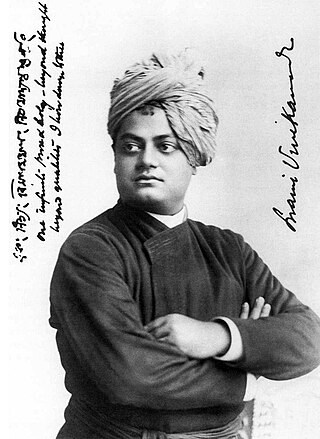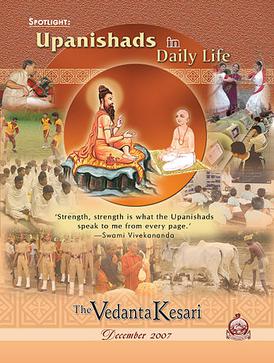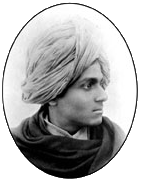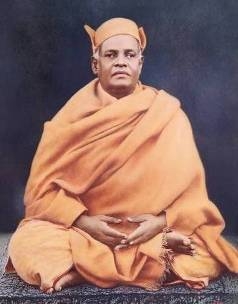
Ramakrishna Mission (RKM) is a Hindu religious and spiritual organisation headquartered in Belur Math, West Bengal. The mission is named after an Indian spiritual Guru Ramakrishna Paramahamsa and founded by Ramakrishna's chief disciple Swami Vivekananda on 1 May 1897. The organisation mainly propagates the Hindu philosophy of Vedanta–Advaita Vedanta and four yogic ideals – Jnana, Bhakti, Karma, and Raja yoga.

Shuddhananda who was the fifth president of the Ramakrishna Order, was a direct monastic disciple of Vivekananda. He joined the Ramakrishna Math in 1897. He became a trustee of Ramakrishna Math and a member of the governing body of Ramakrishna Mission in May 1903. He also took up the editorship of the Bengali magazine called Udbodhan for sometime. He was appointed as the secretary of the math and the mission in 1927 and as the vice president in 1937. In 1938, he became the president of the order. His tenure was short, as he died in 1938. He is renowned in the literary circles to have translated most of Vivekananda's original works from English to Bengali.

Swami Virajananda, born Kalikrishna Bose, was an initiated disciple of Sarada Devi and the sixth president of the Ramakrishna Order. Born as the son of Trailokyanath Bose and Nishadkalidevi, Virajananda was the first person to join the Ramakrishna Order after the direct disciples of Ramakrishna. In 1897, he was initiated into sannyasa by Vivekananda. From 1899 onward he served in Advaita Ashrama, Mayavati and became its president in 1906. He is recognised as a monastic disciple of Vivekananda.

Ramakrishna Math is the administrative legal organization of the Ramakrishna Order, considered part of the Hindu reform movements. It was set up by sanyasin disciples of Ramakrishna Paramhansa headed by Swami Vivekananda at Baranagar Math in Baranagar, a place near Calcutta, in 1886. India. The headquarters of Ramakrishna Math and its twin organisation, Ramakrishna Mission is at Belur Math.

Prabuddha Bharata is an English-language monthly journal of the Ramakrishna Order, in publication since July 1896. It carries articles and translations by monks, scholars, and other writers on humanities and social sciences including religious, psychological, historical, and cultural themes. It has a section of book reviews where important publications from university presses from around the world are reviewed. It is edited from Advaita Ashrama, Mayavati, Uttarakhand, and published and printed in Kolkata. Prabuddha Bharata is India's longest running English journal.

Vedanta Societies refer to organizations, groups, or societies formed for the study, practice, and propagation of Vedanta, the ultimate aim of Vedas. More specifically, they "comprise the American arm of the Indian Ramakrishna movement", and refer to branches of the Ramakrishna Order located outside India.

The Vedanta Kesari is an English language monthly magazine covering spiritual and cultural issues, published by the Ramakrishna Math in Chennai, India, since 1895.

Advaita Ashrama, Mayavati, is a branch of the Ramakrishna Math, founded on 19 March 1899 at the behest of Vivekananda, by his disciples James Henry Sevier, and Charlotte Sevier. Today it publishes the original writings of Vivekananda. As an ashram dedicated to the study and practice of Advaita Vedanta, no images or idols are worshipped there, not even of Ramakrishna; and no images were kept in the premises according to the Ashram ideals set by Vivekananda.

Swarupananda was a direct monastic disciple of Vivekananda and the first president of the Advaita Ashrama, set up by Vivekananda in 1899 at Mayavati, near Champawat. The ashram is a branch of the religious monastic order, Ramakrishna Math, also set up by Vivekananda on the teachings of his guru Ramakrishna.

Sri Ramakrishna Math, Chennai is a monastic organisation for those men who were taught into existence by Sri Ramakrishna (1836–1886), a 19th-century saint of Bengal. The motto of the Ramakrishna Math and Ramakrishna Mission is: "For one's own salvation, and for the welfare of the world". The math in Chennai is the first branch center of the Ramakrishna Order in Southern India. It was established in 1897 by Swami Ramakrishnananda, one of the direct disciples of Sri Ramakrishna. Besides Swami Ramakrishnananda, the Math was visited by Holy Mother Sri Sarada Devi, Swami Nirmalananda, Swami Shivananda, Swami Abhedananda, Swami Premananda, Swami Niranjanananda, Swami Trigunatitananda, and Swami Vijnanananda.

Saradananda, also known as Swami Saradananda, was born as Sarat Chandra Chakravarty in 1865, and was one of the direct monastic disciples of Ramakrishna. He was the first Secretary of the Ramakrishna Math and Ramakrishna Mission, a post which he held until his death in 1927. He established the Udbodhan house in the Bagbazar area of Calcutta, which was built primarily for the stay of Sri Sarada Devi in Calcutta, from where he used to publish the Bengali magazine Udbodhan. There he wrote Sri Sri Ramakrishna Lilaprasanga in Bengali, on the life of Ramakrishna, which was translated into English as Sri Ramakrishna, the Great Master. He is believed to be reincarnation of Saint Peter and he allegedly went into Samadhi when he was in the Saint Peter Church and said that "I remembered my past" and wrote in his diary that "Saint Peter again."

Josephine MacLeod was an American friend and devotee of Swami Vivekananda. She had a strong attachment to India and was an active participant in the Ramakrishna Vivekananda movement. She was given the nicknames "Tantine" and "Jo Jo" by Vivekananda. She considered Swami Vivekananda to be her friend and helped him with his finances. MacLeod was not a sanyasin, unlike many others such as Sister Nivedita or Sister Christine. She was instrumental in spreading Vivekananda's message on Vedanta in the West. She made many contributions to the initial and the later phases of the development of the order of Ramakrishna and Vivekananda. She was a contributor to many causes espoused by Sister Nivedita, the most famous disciple of Vivekananda, including that of contributing financially towards the development of the Indian National Movement especially in Bengal and elsewhere in India.

Bartaman Bharat is a Bengali language essay written by Indian Hindu monk Swami Vivekananda. The essay was first published in the March 1899 issue of Udbodhan, the only Bengali language magazine of Ramakrishna Math and Ramakrishna Mission. The essay was published as a book in 1905, and later it was compiled into the fourth volume of The Complete Works of Swami Vivekananda.
Alambazar Math is the second monastery of the Ramakrishna Order established in February 1892, which remained the order's headquarters till February 1898, when it was finally moved to Belur village on the bank of Ganga.

Sri Ramakrishna the Great Master, translated by Swami Jagadananda, is an English translation of the Bengali biography Sri Ramakrishna Leela Prasanga, of Sri Ramakrishna, the 19th-century Indian saint and mystic. Its Bengali original was written by Swami Saradananda, which is based on interviews of persons who knew or interacted with him. It is therefore a first-hand source. The original Bengali version published was composed in five volumes and was the first full-scale biography of the saint. This is an eyewitness account and therefore carries more credibility than later books on Sri Ramakrishna. The English translation was first published in 1952. The original Bengali book was written from 1909 to 1919, over a period of ten years, in order to repay the debt incurred for constructing Udbodhan House for Holy Mother Sri Sarada Devi.

Prakashananda (1874–1927) was a direct monastic disciple of Vivekananda and a swami monk of the Ramakrishna Order who played a major role in propagating and promoting the Vedanta philosophy and Vivekananda's message in India and America. He worked closely with Trigunatitananda, a direct disciple of Ramakrishna for Vedanta Society of San Francisco, later renamed as Vedanta Society of Northern California, and later became its president.
Vimalananda (1872–1908) was an Indian spiritual writer who was one of the monastic disciples of Vivekananda and an early monk of the Ramakrishna Order. He was involved in the publication of Prabuddha Bharata. He was actively involved in running day-to-day operations of the Advaita Ashrama at Mayavati during the early days of the Ashrama. He also inaugurated the Ramakrishna Math at Ulsoor in Bangalore in 1906. He died in 1908 at the Mayavati Ashrama.

Swami Samarpanananda is an Indian author and a monk of the Ramakrishna Mission, Belur Math.
Sri Sarada Math is named after Sri Sarada Devi, the consort of Sri Ramakrishna, and founded on 2 December 1954. Built by a group of eight sadhavis, as per the instructions given by Swami Vivekananda, it serves as a monastic order for women. Headquartered at Dakshineshwar, Kolkata, the organisation has branch centres all over India, in Sri Lanka and Australia. The nuns of this order use the title "Pravrajika" before their ordained name, and are usually addressed as "Mataji" meaning 'revered mother'.
















